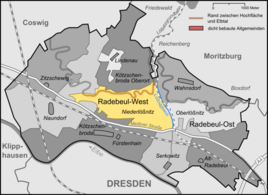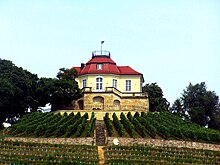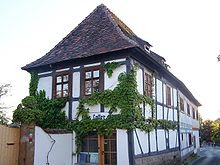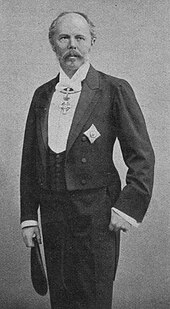Niederlößnitz (Radebeul)
|
Niederloessnitz
Major district town of Radebeul
Coordinates: 51 ° 6 ′ 35 ″ N , 13 ° 38 ′ 40 ″ E
|
|
|---|---|
| Height : | 110–155 m above sea level NN |
| Area : | 2.59 km² |
| Incorporation : | 1923 |
| Incorporated into: | Kötzschenbroda |
| Postal code : | 01445 |
| Area code : | 0351 |
|
Location of the district within Radebeul
|
|
Niederlößnitz is now a district of the city of Radebeul in the district of Meißen in Saxony . It is located north of Meißner Straße between Naundorf / Zitzschewig in the west and Oberlößnitz / Wahnsdorf in the east, separated from the latter by the Lößnitzgrund , through which the narrow-gauge Lößnitz dachshund drives. In the south lies Kötzschenbroda and in the north Kötzschenbroda Oberort . Today Niederlößnitz is mainly characterized by the viticulture of the two individual layers Radebeuler Steinrück and Radebeuler Johannisberg within the large Lößnitz area as well as the development of villas after the phylloxera disaster from the 1880s. Because of this development, Nieder- and Oberlößnitz are now popular villa suburbs in the state capital of Dresden .
Niederlößnitz was founded in 1839 mainly from Kötzschenbrodaer Weinbergsflur and was an independent rural community, one of the Lößnitz localities , until it was reunited with Kötzschenbroda in 1923 . From 1923 Niederlößnitz formed together with Kötzschenbroda with Fürstenhain , Naundorf and Zitzschewig the large community of Kötzschenbroda (today Radebeul-West ), which received city rights in 1924 . With the unification of Radebeul and Kötzschenbroda in 1935, Niederlößnitz became a district of Radebeul, which encompasses the entire Lößnitz landscape.
Just like Oberlößnitz, which was founded in the same year 1839, Niederlößnitz has no village center, unlike the other eight districts that belong to Radebeul. The district Niederlößnitz had in 1900 a size of 259 hectares, about 10% of the total today's urban area. Today Niederlößnitz forms a common area together with Kötzschenbroda, Fürstenhain and Kötzschenbroda-Oberort.
history
The corridor was mentioned in documents as "Kötzschbergisches Weingebirge" around 1271, until the 17th century mainly viticulture took place here. The Lezenitzberg vineyard , which was mentioned in 1286 and belongs to the Reinhardtsberg family, gave the Lößnitz its name. From the 16th century onwards, more and more wineries were added to the previously only isolated press houses on the vineyard corridor, which, as manor or owner mountains, were not administered by Kötzschenbroda, but directly from the office ( Dresden Office ). Around 1600 there were 21 buildings on Hausgass (today Winzerstraße).
The goods consisted of a winegrower's house with outbuildings, the wine press was often located in the winegrower's house, and the larger ones also had rooms for the external vineyard owners. The Lößnitz style consisted of solid dry stone -first floor, half-timbered -Obergeschoss with open gear before and a high hip roof , rarely a gable roof .
Occasionally, vineyard mansions were built as early as the Baroque period , for example the Grundhof in 1652 and the Fly Wedel house in 1675 . During and after the reign of August the Strong , more and more country houses were built in Niederlößnitz, for example the Minckwitz manor on the Minckwitz vineyard in 1713 , Wackerbarths Ruh ' from 1727 , Altfriedstein in 1743 and Neufriedstein with its mountain house (Mätressenschlösschen) in 1771 .
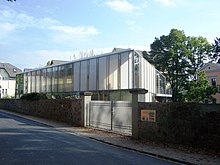
In 1832, 75 winegrowers who had settled on the Kötzschenbroda corridor north of Meißner Strasse, but were not considered to be their residents by the Kötzschenbroda community, founded the Niederlößnitzer Weinbergverein . Due to the changes in the Saxon rural community order of 1838 , the municipality Nieder-Lössnitz with 400 inhabitants at that time was formed in 1839 through formal separation from Kötzschenbroda . The meeting took place in the “ Zur Weintraube ” inn . The community was between Kötzschenbroda in the south and Kötzschenbroda Oberort in the north. The three vineyard areas Neufriedstein, Flywedel and Wackerbarths Ruh ', which originally lay on the Naundorf vineyard floor, were also included.
In 1863 the Diakonissenanstalt Dresden opened the Diakonissenanstalt Bethesda (today Elblandklinikum Radebeul) in Niederlößnitz , and in the following year the Magdalenasyl “Talitha kumi” was set up on the neighboring property (today Hedwig-Fröhlich-Haus). The construction company "Gebrüder Ziller" , founded in Oberlößnitz in 1867, built the Mohrenhaus in Niederlößnitz from 1868 to 1871 and the Friedensburg in 1870/1871 . Similar to the Dresden architects Schilling & Graebner , she also acquired entire quarters here, developed them in the form of the villa colony concept and built many houses that are now listed and characterize the cityscape. In 1895 the town hall of the municipality on Königsplatz (today Rosa-Luxemburg-Platz 1) was inaugurated. The statute of the townscape valid for Niederlößnitz at that time forbade, in contrast to Oberlößnitz, the settlement of businesses. So the Sektkellerei Bussard remained one of the few exceptions in the emerging country house quarters.
The Kötzschenbrodaer Zeitung , published since 1865, also served as the official gazette in Niederlößnitz from 1876 .
As of 1912, the community, like some other Saxon communities, raised a cat tax of 3 marks (based on today's value (2018): 20 euros) for the first cat, 6 marks for each additional cat , as a result of efforts to protect birds .
During the First World War, French prisoners of war stayed in the Loessnitz. In 1916 they built the water tower that stands prominently on the edge of the Elbe slope .
On October 1, 1923, the town's 84-year independence ended. At that time it had about 5000 inhabitants. Niederlößnitz was again incorporated into Kötzschenbroda and in 1935, together with Kötzschenbroda, became part of the newly created urban district of Radebeul.
On May 2, 1959, the public observatory "Adolph Diesterweg" was inaugurated on the edge of the Elbe slope, and on October 3, 1969 it was given a new planetarium .
Development of the population
The population development began when the community was founded in 1839 with around 600 residents of the estates that were scattered over the vineyards and were generally managed as singuli by the Dresden office. With the early days and above all the development of the abandoned vineyards to villa quarters, the number of inhabitants multiplied due to the popularity of the residential area. When it united with Kötzschenbroda, more than 5,000 residents lived in Niederlößnitz.
| year | 1832 | 1839 | 1849 | 1871 | 1890 | 1910 | 1919 | 1923 |
|---|---|---|---|---|---|---|---|---|
| Residents | 358 | about 600 | 653 | 1,193 | 2,920 | 4,750 | 4,964 | approx. 5,200 |
Community boards, community elders and community council members
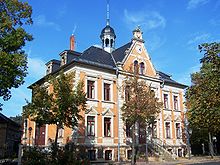
In over 80 years, only six parish councils were active for Niederlößnitz. The last one, Oswald Hans, was then in office for another six years, then as a community chairman / mayor for the united city of Kötzschenbroda . On the 25th anniversary of his service, Hans received the honorary citizenship of Kötzschenbroda in 1929 .
- 1839–1845: Heinrich August Hilliger
- 1846–1867: Otto Heinrich Schenk
- 1867–1869: Wilhelm Häbold
- 1869–1892: Christian Friedrich Petz
- 1893–1903: Max Justus Heinrich Herz (1858–1903)
- 1904–1923 (–1929): Oswald Hans (1866–1946)
Already in 1839 when the rural community Niederlößnitz was founded, Johann Friedrich Anton Dehne was elected first community elder by an absolute majority .
In 1892, the builder Adolf Neumann was a member of the municipal council when he applied for the construction of a town hall, which was also implemented by Neumann following the approval.
In 1896, Alfred Naumann moved to Niederlößnitz, where he became a member of the local council that same year, to which he belonged until his death in 1917, ultimately becoming the first community elder . As chairman of the building committee, he made numerous contributions to the local building regulations, which the Niederlößnitz preserved the character of the villa development.
Cultural monuments
Characteristic for the district is the landscape protection area , which, with its drained vineyard walls , was placed under the protection of regional monuments in 1999 as the historical Radebeul vineyard landscape . This stretches from Oberlößnitz in the east via Niederlößnitz and Naundorf to Zitzschewig.
In Niederlößnitz, Wackerbarth Castle, with the vineyards high up beyond the Jacobstein, is a monument preservation entity that merges seamlessly into the entity of the Neufriedstein vineyards. Another such extensive entity is the estate of the Minckwitz vineyard with its buildings and park. The settlement of the Kötzschenbroda building cooperative from the 1920s and the Gröba settlement , a "civil servant residential group" of the Gröba electricity association , designed by the architect Alfred Tischer in the mid-1920s, are considered to be smaller entities . The new administration building of the Gröba Electricity Association was built by the architect Otto Rometsch in 1925 at Körnerweg 5.
The estate of Wackerbarth including the adjoining vineyard fly whisk counts as well as the winery estate of Minckwitzschen vineyard as a work of landscape and garden design . These include the large gardens of the listed Villa Hildebrandt at Borstrasse 27, the country house at Winzerstrasse 35 and the Frenzel House at Karlstrasse 8.
Several properties in Niederlößnitz are also listed in the monument-preservation ancillary facilities . These are the Grundhof as well as the formerly belonging property Paradiesstraße 56 . There are also the two housing estates east of Rosa-Luxemburg-Platz, including the addresses Rosa-Luxemburg-Platz 2/3 . Further to the west is the Villa Bernhard Große property at Heinrich-Heine-Straße 10 and a little north of it the Villa Ernst Louis Kempe property at Bodelschwinghstraße 8. The outdoor area of the listed Mohrenhaus also falls under this category, the area extends from the Moritzburger Straße far to the west, in the middle of the forest there is still an artificial ruin.
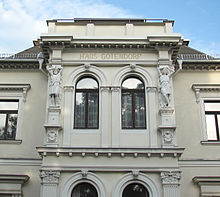
In addition, there are the monuments standing on the edge of the Elbe slope, the Lößnitzhöhen, such as the Jacobstein , the Mätressenschlösschen , the Friedensburg and the Minckwitzsche Weinberghaus , which are visible from afar like landmarks of the district. From these, residents and visitors have a wide view of the Elbe and the hinterland. The vineyard areas can be seen particularly well from above, but also large individual monuments such as Wackerbarths Ruh ' , located on the western edge of Niederlößnitz , today the seat of the Saxon State Winery as Wackerbarth Castle . Right next to it is the baroque house Fly Wedel , a little further east Neufriedstein and Altfriedstein .
Along the Winzerstraße there are wineries like the Möbius house and the Lotter house , which is already shown on Matthias Oeder's maps. The Lezenitzberg vineyard , which was mentioned in 1286 and belongs to the Reinhardtsberg family, gave the Lößnitz its name. Vineyard houses did not always stay in their original condition, but were later also rebuilt, such as the house on Finsteren Gasse 2 . In the 19th century, Late Classicist buildings such as the Landhaus in Heinrich-Zille-Straße 61 and Swiss-style houses such as the Villa Jenny or the gardener's house at the Goldschmidtvilla were built in Niederlößnitz . Around 1900, buildings such as the Goldschmidtvilla or the villa at Rennerbergstraße 9 were built here , but also the reform architecture country houses in the Altfriedstein villa colony .
Other listed buildings in Niederlößnitz are the Untere Berghaus , the Landhaus Kurt Keller , the Landhaus Körnerweg 10 , the Landhaus Mehlhorn , the Haus Clauss , the Atelierpavillon Otto Jantzen , the Villa Maximilian August von Schmieden , the Villa Heimburg , the Villa Alfred Sparbert , the Villa Hedwig , Villa Käthe , Villa Waldhof , Villa Zillerstraße 11 , Villa Schuchstraße 4 and Villa Blumenstraße 5 .
Personalities

August Christoph von Wackerbarth (* 1662; † 1734), Saxon field marshal, had the manor Wackerbarths Ruh ' built in Lößnitz from 1727–1729 as a retirement home . The poet and singer Elise Polko († May 15, 1899 in Munich) was born there on January 13, 1822 . The Saxon and Prussian statesman Albert von Carlowitz (born April 1, 1802 in Freiberg) lived in Niederlößnitz, where he died at the age of 72 on August 9, 1874 at Wackerbarth Castle.
Shortly before his death, the former Saxon Prime Minister Heinrich von Brühl acquired the Rooseschen Weinberg (later Altfriedstein ) in 1763 and named it Mon Repos .
The painter Julius von Leypold (* 1806 in Dresden) died in Niederlößnitz in 1874. The draftsman and illustrator Herbert König (* 1820 in Dresden; † June 13, 1876) settled in Niederlößnitz towards the end of his life, where he also died. The painter and traveler Wilhelm Heine (born January 30, 1827 in Dresden; † October 5, 1885) settled in Niederlößnitz around 1880. The Austrian conductor and Saxon general music director Ernst von Schuch (born November 23, 1846 in Graz) moved with his wife Clementine von Schuch-Proska to Niederlößnitz in 1882, where he died on May 10, 1914. He became famous through his collaboration with Richard Strauss at the Dresden Court Opera. In 1878 the actor Walter Steinbeck (born September 26, 1878, † August 27, 1942 in Berlin) was born in Niederlößnitz . The art historian and architect as well as the founder of the Saxon inventory work Richard Steche (born February 17, 1837 in Leipzig; † January 3, 1893) lived in Niederlößnitz for the last four years of his life.
In Grundhof lived and worked constantly artist, the painter Wilhelm Claus (* 1882 in Breslau, † 1914 in Paris) was staying, who from 1905 in Dresden and Radebeul and with the living there until 1972 painter Karl Kröner (1887-1972) friends was. Today Gunter Herrmann, a freelance painter and graphic artist who has been living there since 1962.
The sculptor Burkhart Ebe (born November 4, 1881 in Berlin; † February 16, 1949) moved with his family to Niederlößnitz in 1920. The archivist and historian Woldemar Lippert (born October 17, 1861 in Dresden; † June 10, 1937) died in Niederlößnitz. Jeanne Berta Semmig (born May 16, 1867 in Orléans; † July 28, 1958), a German writer and poet, spent her old age in the “Altfriedstein” retirement home.
The Minckwitz'sche Weinberghaus is now the seat of the family archive of the descendants of the Dresden sculptor Ernst Rietschel (1804–1863).
Oswald Hans (born June 18, 1866 in Glauchau; † January 13, 1946 in Radebeul) was a full-time parish chairman of Niederlößnitz from 1904 and, as such, made a contribution to the expansion of the community's infrastructure. As one of the pioneers in the unification of the western Lößnitz communities into the large community of Kötzschenbroda, he became the first mayor of the city from 1924 to 1929 when Kötzschenbroda was granted city rights . In 1929, on his 25th anniversary in office, Hans received the honorary citizenship of Kötzschenbroda.
See also
- List of streets and squares in Radebeul-Niederlößnitz
- List of cultural monuments in Radebeul-Niederlößnitz
literature
- Frank Andert (Red.): Radebeul City Lexicon . Historical manual for the Loessnitz . Published by the Radebeul City Archives. 2nd, slightly changed edition. City archive, Radebeul 2006, ISBN 3-938460-05-9 .
- Cornelius Gurlitt : Niederlössnitz. In: Descriptive representation of the older architectural and art monuments of the Kingdom of Saxony. 26. Booklet: The art monuments of Dresden's surroundings, Part 2: Amtshauptmannschaft Dresden-Neustadt . CC Meinhold, Dresden 1904, p. 125 ff.
- Volker Helas (arrangement): City of Radebeul . Ed .: State Office for Monument Preservation Saxony, Large District Town Radebeul (= Monument Topography Federal Republic of Germany . Monuments in Saxony ). SAX-Verlag, Beucha 2007, ISBN 978-3-86729-004-3 .
- Karl Julius Hofmann: The Meissen Netherlands in its natural beauties and peculiarities or Saxon Italy in the Meissen and Dresden areas with their localities. A folk book for nature and patriot friends presented topographically, historically and poetically . Louis Mosche, Meißen 1853. ( limited preview in google book search)
- Moritz Eduard Lilie: Chronicle of the Loessnitz localities Kötzschenbroda, Niederlößnitz, Radebeul, Oberlößnitz with Hoflößnitz Serkowitz Naundorf, Zitzschewig and Lindenau with special consideration of Coswig and the other neighboring towns . Niederlößnitz 1893 ( digitized version )
- Adolf Schruth; Manfred Richter (arrangement): Chronicle Niederlößnitz . Radebeul 2010 ( Online [PDF; 427 kB ] First edition: 1930).
- Gustav Wilhelm Schubert : Chronicle and topography of the parish Kötzschenbroda, which encompasses the market towns of Kötzschenbroda and the small village of Fürstenhain, the villages of Nauendorf, Zitzschewig and Lindenau, together with historical general notes. In the main, etc.zusammengestellt due documentary news . Self-published by the author, Dresden (1864 and) 1865.
- Gustav Wilhelm Schubert: Viticulture in the, the market town of Kötzschenbroda together with the village of Fürstenhain, the Hof- and Niederlößnitz, Nauendorf, Zitzschewig and Lindenau, parish Kötzschenbroda by age, reputation and scope, along with historical notes about the Königl. Saxon. Viticulture in general, and especially about the vine culture in Meißnischen . Self-published by the author, Dresden 1865.
Web links
- Niederlößnitz in the Digital Historical Directory of Saxony
- All photos and scans of Niederlößnitz at the Deutsche Fotothek
- Niederlößnitz from yesteryear ( Memento from June 4, 2016 in the Internet Archive )
- Manfred Richter: From the vineyard association to the political community. In: Niederlößnitz from yesteryear. Archived from the original on March 4, 2016 ; accessed on June 4, 2016 .
- City map Niederlößnitz around 1924 ( Memento from September 27, 2016 in the Internet Archive )
- Niederlößnitz streets and their history ( Memento from June 4, 2016 in the Internet Archive )
- Location of the district at OpenStreetMap
Individual evidence
- ^ Niederlößnitz in the Digital Historical Directory of Saxony
- ^ Frank Andert (Red.): Radebeul City Lexicon . Historical manual for the Loessnitz . Published by the Radebeul City Archives. 2nd, slightly changed edition. City archive, Radebeul 2006, ISBN 3-938460-05-9 , p. 262 .
- ↑ a b c d Manfred Richter: From the vineyard association to the political community. In: Niederlößnitz from yesteryear. Archived from the original on March 4, 2016 ; Retrieved October 30, 2010 .
- ^ Frank Andert (Red.): Radebeul City Lexicon . Historical manual for the Loessnitz . Published by the Radebeul City Archives. 2nd, slightly changed edition. City archive, Radebeul 2006, ISBN 3-938460-05-9 , p. 264 .
- ^ Adolf Schruth; Manfred Richter (arrangement): Chronicle Niederlößnitz . Radebeul 2010, p. 15 (first edition: 1930).
- ↑ Volker Helas (arrangement): City of Radebeul . Ed .: State Office for Monument Preservation Saxony, Large District Town Radebeul (= Monument Topography Federal Republic of Germany . Monuments in Saxony ). SAX-Verlag, Beucha 2007, ISBN 978-3-86729-004-3 , p. 259-260 .
- ↑ Justification in accordance with Section 21, Paragraph 3 of the Saxon Monument Protection Act on the statutes for the monument protection area "Historical Radebeul Vineyard Landscape"
